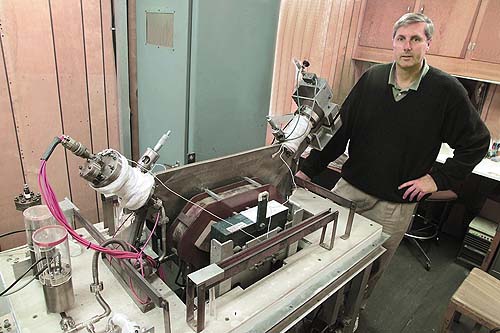 he San Andreas Fault, a classic strike-slip fault, marks the boundary where the Pacific plate collides with the North American plate. The forces at the boundary are compressional, but fault failure is by shear, as the Pacific plate slides steadily (if intermittently) northward.
he San Andreas Fault, a classic strike-slip fault, marks the boundary where the Pacific plate collides with the North American plate. The forces at the boundary are compressional, but fault failure is by shear, as the Pacific plate slides steadily (if intermittently) northward.
Laboratory measurements of friction between the materials of the fault zone suggest that considerable shear stress should be required for the fault to fail and the earth to move sideways -- much more than geologists actually observe.
"The forces and movement of the fault should produce frictional heating," says geochemist Mack Kennedy of the Earth Sciences division, "but paradoxically, nobody's seen the expected heating in the vicinity of the fault. One possibility is that high-pressure fluids are acting as a sort of lubricant."

|
(Click on image to enlarge)
|
|
Geochemist Mack Kennedy determines helium ratios using a sophisticated gas-separation system and mass spectrometer, all mounted in a truck trailer that can go on location when necessary.
|
Indeed, abnormally high pressures have been measured in rock pores at shallow depths adjacent to the fault, but what lies deeper is still a mystery, and geologists have proposed drilling a deep hole right through the fault, three kilometers deep or more.
"It occurred to us that if a bore hole encountered fluids, we would need to know where they came from," says Kennedy. "We located all the springs, seeps, and wells we could that showed evidence of deep-circulating fluids and sampled them for carbon dioxide, hydrogen, noble gases, and so on. The fluid chemistry was in equilibrium with the local geology, as we'd expected, but in the course of this work, we found a helium-three signature in all the samples, which we did not expect."
The Earth's atmosphere contains fewer than one and a half rare helium-three atoms (which have only one neutron in their nucleus) for every million atoms of helium four. In crustal fluids, which include groundwater, the ratio is even less -- only two hundredths of the ratio in air. But in mantle fluids, the ratio of helium three to helium four is about eight times greater than in the air. When Kennedy found high ratios of helium three to helium four in the San Andreas fluids, it was a telling clue to their deep origin.
Two competing models seek to explain the origin of high-pressure fluids in fault zones. One, the "closed box" model proposed by J. D. Byerlee, N. H. Sleep, and M. L. Blanpied, suggests that local crustal fluids are drawn into a fault zone when the fault ruptures and become trapped there by mineral reactions; then, when the sealed fault zone compacts, the high pressures required to weaken it are re-established.
In the model proposed by J. R. Rice, by contrast, high fluid pressure in the fault is only the tip of a vertical "tongue" of high-pressure fluids originating in the mantle, 30 kilometers deep and deeper, which is focused into the fault zone by a root zone through the ductile base of the crust.
| Lead scientist on this project
|
|
|
|
|
|
Kennedy and his colleagues found helium three to helium four ratios in fluids from the San Andreas Fault region which varied, from over a tenth to as much as four times the ratio in air -- high ratios unrelated to the fluid chemistry in the local rocks.
"Some of this fluid could have come only from the mantle," says Kennedy. "The Rice model is at least partially correct."
The discoveries raise interesting questions about the structure of the fault itself. As fluids flow upward, helium three from the mantle is increasingly diluted by helium four produced by the steady radioactive decay of elements in the crust. Thus the ratio at a given site yields an estimate of how quickly the fluid reached that site from the mantle.
The distribution of Kennedy's results leaves open the possibility that mantle fluid is flowing into the San Andreas Fault from great distances away -- perhaps from "as far east as the Sierra Nevada, maybe even under the Sierra," says Kennedy, noting the unusual presence of soda springs near the crest of the Sierra which contain carbon dioxide that may have come from the mantle.
"We don't know the chemistry of the mantle fluid," Kennedy says, "but it's likely to be rich in carbon dioxide and perhaps water under tremendous pressure. We'd really like to get fluids directly from the fault, to help us understand what makes the fault move the way it does. That's one of several good reasons to bore a deep well."
- Paul Preuss



 he San Andreas Fault, a classic strike-slip fault, marks the boundary where the Pacific plate collides with the North American plate. The forces at the boundary are compressional, but fault failure is by shear, as the Pacific plate slides steadily (if intermittently) northward.
he San Andreas Fault, a classic strike-slip fault, marks the boundary where the Pacific plate collides with the North American plate. The forces at the boundary are compressional, but fault failure is by shear, as the Pacific plate slides steadily (if intermittently) northward.

